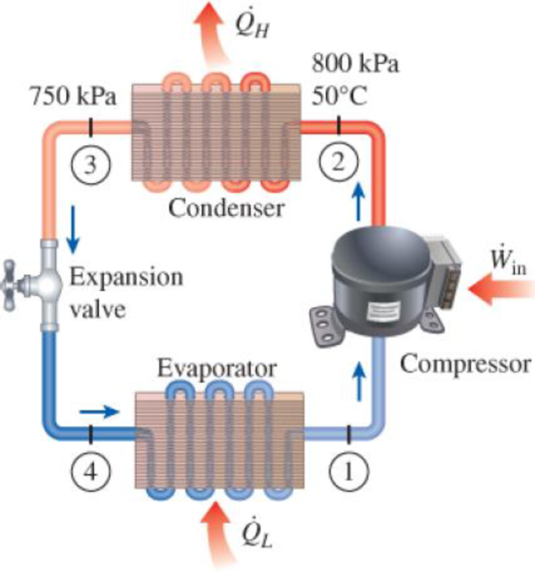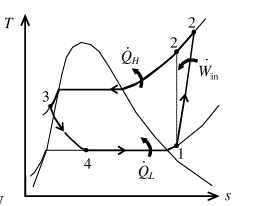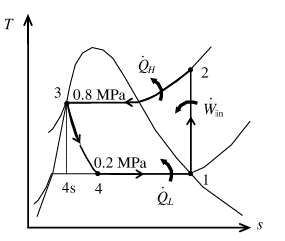
Refrigerant-134a enters the condenser of a residential heat pump at 800 kPa and 50°C at a rate of 0.022 kg/s and leaves at 750 kPa subcooled by 3°C. The refrigerant enters the compressor at 200 kPa superheated by 4°C. Determine (a) the isentropic efficiency of the compressor, (b) the rate of heat supplied to the heated room, and (c) the COP of the heat pump. Also, determine (d) the COP and the rate of heat supplied to the heated room if this heat pump operated on the ideal vapor-compression cycle between the pressure limits of 200 and 800 kPa.
FIGURE P11–42

(a)
The isentropic efficiency of the compressor.
Answer to Problem 42P
The isentropic efficiency of the compressor is
Explanation of Solution
Show the T-s diagram for process as in Figure (1).

From Figure (1), write the specific enthalpy at state 3 is equal to state 4 due to throttling process.
Here, specific enthalpy at state 3 and 4 is
Express isentropic efficiency of the compressor.
Here, specific enthalpy at state 1, 2 and 2s is
Express the temperature at state 3.
Here, saturated temperature at pressure of
Express the temperature at state 1.
Here, saturated temperature at pressure of
Express quality at state 2s.
Here, specific entropy at saturated liquid and evaporation and
Express specific enthalpy at state 2s.
Here, specific enthalpy at saturated liquid and evaporation and
Conclusion:
Perform unit conversion of pressure at state 2 from
Refer Table A-13, “superheated refrigerant 134a”, and write the specific enthalpy at state 2 corresponding to pressure at state 2 of
Refer Table A-12, “saturated refrigerant-134a-pressure table” and write saturated temperature at pressure of
Substitute
Refer Table A-12, “saturated refrigerant-134a-pressure table” and write specific enthalpy at state 3 corresponding to pressure at state 3 of
Write the formula of interpolation method of two variables.
Here, the variables denote by x and y is temperature at state 3 and specific enthalpy at state 3 respectively.
Show the specific enthalpy at state 3 corresponding to temperature as in Table (1).
|
Temperature at state 3 |
Specific enthalpy at state 3 |
| 26.69 | 88.82 |
| 26.06 | |
| 29.06 | 92.22 |
Substitute
Since the specific enthalpy at state 3 is equal to state 4 due to throttling process.
Refer Table A-12, “saturated refrigerant-134a-pressure table” and write saturated temperature at pressure of
Substitute
Refer Table A-12, “saturated refrigerant-134a-pressure table” and write specific enthalpy and entropy at state 1 corresponding to pressure at state 1 of
Here, specific entropy at state 1 is
The specific entropy at state 1 is equal to specific entropy at state 1.
Here, specific entropy at state 2 is
Refer Table A-12, “saturated refrigerant-134a-pressure table” and write the properties corresponding to pressure at state 2 of
Substitute
Substitute
Substitute
Hence, the isentropic efficiency of the compressor is
(b)
The rate of heat supplied to the heated room.
Answer to Problem 42P
The rate of heat supplied to the heated room is
Explanation of Solution
Express the rate of heat supplied to the heated room.
Here, mass flow rate is
Conclusion:
Substitute
Hence, the rate of heat supplied to the heated room is
(c)
The COP of the heat pump.
Answer to Problem 42P
The COP of the heat pump is
Explanation of Solution
Express the rate of work input.
Express coefficient of performance of heat pump.
Conclusion:
Substitute
Substitute
Hence, the COP of the heat pump is
(d)
The COP and the rate of heat supplied to the heated room.
Answer to Problem 42P
The COP and the rate of heat supplied to the heated room is
Explanation of Solution
Show the T-s diagram for ideal vapor compression cycle as in Figure (2).

From Figure (2), write the specific enthalpy at state 3 is equal to state 4 due to throttling process.
Express the coefficient of performance.
Express the rate of heat supplied to the heated room.
Conclusion:
Refer Table A-12, “saturated refrigerant-134a-pressure table”, and write the properties corresponding to initial pressure of
Here, specific entropy at state 1 is
Refer Table A-13, “superheated refrigerant 134a”, and write the specific enthalpy at state 2 corresponding to pressure at state 2 of
Show the specific enthalpy at state 2 corresponding to specific entropy as in Table (2).
|
Specific entropy at state 2 |
Specific enthalpy at state 2 |
| 0.9185 | 267.34 |
| 0.9379 | |
| 0.9481 | 276.46 |
Use Excels and substitute the values from Table (2) in Equation (VI) to get,
Refer Table A-12, “saturated refrigerant-134a-pressure table”, and write the specific enthalpy at state 3 corresponding to pressure at state 3
Here, specific enthalpy at saturated liquid is
Since the specific enthalpy at state 3 is equal to state 4 due to throttling process.
Substitute
Substitute
Hence, the COP and the rate of heat supplied to the heated room is
Want to see more full solutions like this?
Chapter 11 Solutions
Thermodynamics: An Engineering Approach
- Given: = refueling Powertran SOURCE EMISSIONS vehide eff eff gasoline 266g co₂/kwh- HEV 0.90 0.285 FLgrid 411ilg Co₂/kWh 41111gCo₂/kWh EV 0.85 0.80 Production 11x10% og CO₂ 13.7 x 10°g CO₂ A) Calculate the breakeven pont (in km driven) for a EV against on HEV in Florida of 0.1kWh/kM Use a drive cycle conversion 5) How efficient would the powertrain of the HEV in this example have to be to break even with an EV in Florida after 150,000 Miles of service (240,000) km Is it plausible to achieve the answer from pert b Consideans the HaXINERY theoretical efficiency of the Carnot cycle is 5020 and there are additional losses of the transMISSION :- 90% efficiency ? c A what do you conclude is the leading factor in why EVs are less emissive than ICE,arrow_forwardsolve autocontrolsarrow_forwardProblem 3.21P: Air at 100F(38C) db,65F(18C) wb, and sea-level pressure is humidified adiabatically with steam. The steam supplied contains 20 percent moisture(quality of 0.80) at 14.7psia(101.3kpa). The air is humidified to 60 percent relative humidity. Find the dry bulb temperature of the humidified air using (a)chart 1a or 1b and (b) the program PSYCH.arrow_forward
- A pump delivering 230 lps of water at 30C has a 300-mm diameter suction pipe and a 254-mm diameter discharge pipe as shown in the figure. The suction pipe is 3.5 m long and the discharge pipe is 23 m long, both pipe's materials are cast iron. The water is delivered 16m above the intake water level. Considering head losses in fittings, valves, and major head loss. a) Find the total dynamic head which the pump must supply. b)It the pump mechanical efficiency is 68%, and the motor efficiency is 90%, determine the power rating of the motor in hp.given that: summation of K gate valve = 0.25check valve=390 degree elbow= 0.75foot valve= 0.78arrow_forwardA pump delivering 230 lps of water at 30C has a 300-mm diameter suction pipe and a 254-mm diameter discharge pipe as shown in the figure. The suction pipe is 3.5 m long and the discharge pipe is 23 m long, both pipe's materials are cast iron. The water is delivered 16m above the intake water level. Considering head losses in fittings, valves, and major head loss. a) Find the total dynamic head which the pump must supply. b)It the pump mechanical efficiency is 68%, and the motor efficiency is 90%, determine the power rating of the motor in hp.arrow_forwardThe tensile 0.2 percent offset yield strength of AISI 1137 cold-drawn steel bars up to 1 inch in diameter from 2 mills and 25 heats is reported as follows: Sy 93 95 101 f 97 99 107 109 111 19 25 38 17 12 10 5 4 103 105 4 2 where Sy is the class midpoint in kpsi and fis the number in each class. Presuming the distribution is normal, determine the yield strength exceeded by 99.0% of the population. The yield strength exceeded by 99.0% of the population is kpsi.arrow_forward
- Solve this problem and show all of the workarrow_forwardI tried to go through this problem but I don't know what I'm doing wrong can you help me?arrow_forwardGenerate the kinematic diagram of the following mechanisms using the given symbols. Then, draw their graphs and calculate their degrees of freedom (DoF) using Gruebler's formula. PUNTO 2. PUNTO 3. !!!arrow_forward
 Elements Of ElectromagneticsMechanical EngineeringISBN:9780190698614Author:Sadiku, Matthew N. O.Publisher:Oxford University Press
Elements Of ElectromagneticsMechanical EngineeringISBN:9780190698614Author:Sadiku, Matthew N. O.Publisher:Oxford University Press Mechanics of Materials (10th Edition)Mechanical EngineeringISBN:9780134319650Author:Russell C. HibbelerPublisher:PEARSON
Mechanics of Materials (10th Edition)Mechanical EngineeringISBN:9780134319650Author:Russell C. HibbelerPublisher:PEARSON Thermodynamics: An Engineering ApproachMechanical EngineeringISBN:9781259822674Author:Yunus A. Cengel Dr., Michael A. BolesPublisher:McGraw-Hill Education
Thermodynamics: An Engineering ApproachMechanical EngineeringISBN:9781259822674Author:Yunus A. Cengel Dr., Michael A. BolesPublisher:McGraw-Hill Education Control Systems EngineeringMechanical EngineeringISBN:9781118170519Author:Norman S. NisePublisher:WILEY
Control Systems EngineeringMechanical EngineeringISBN:9781118170519Author:Norman S. NisePublisher:WILEY Mechanics of Materials (MindTap Course List)Mechanical EngineeringISBN:9781337093347Author:Barry J. Goodno, James M. GerePublisher:Cengage Learning
Mechanics of Materials (MindTap Course List)Mechanical EngineeringISBN:9781337093347Author:Barry J. Goodno, James M. GerePublisher:Cengage Learning Engineering Mechanics: StaticsMechanical EngineeringISBN:9781118807330Author:James L. Meriam, L. G. Kraige, J. N. BoltonPublisher:WILEY
Engineering Mechanics: StaticsMechanical EngineeringISBN:9781118807330Author:James L. Meriam, L. G. Kraige, J. N. BoltonPublisher:WILEY





